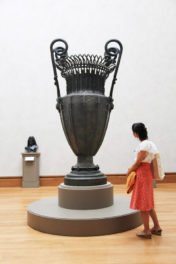We’ve asked curators from the Getty Museum and Getty Research Institute to share short reflections on works of art they’re thinking about right now. These recordings feature stories related to our daily lives.
This week, curator David Saunders reflects on how a painted vase from around 510 BCE that shows Ajax and Achilles playing board games helps him make sense of his work-from-home life. Learn more about this artwork.
Over the next few weeks, look for new recordings every Tuesday.

Attic black-figure neck amphora, about 510 BCE, attributed to the Medea Group. Terracotta, 14 1/4 × 9 1/4 in. The J. Paul Getty Museum, 71.AE.441. Digital image courtesy of Getty’s Open Content Program
Transcript


JAMES CUNO: Hi, I’m Jim Cuno, president of the J. Paul Getty Trust. As we all adapt to working and living under these new and unusual circumstances, we’ve asked curators from the Getty Museum and Getty Research Institute to share short reflections on works of art they’re thinking about right now. We’ll be releasing new recordings on Tuesdays over the next few weeks. I hope you’ll find these stories about our daily lives—from laundry on the line to a dog at a scholar’s feet—thought provoking, illuminating, and entertaining.
DAVID SAUNDERS: Hi there, my name is David Saunders. I’m a curator in the Antiquities department. One of the objects that I’ve been looking at with renewed interest and perspective is this Athenian black figure neck amphora that shows Ajax and Achilles playing a board game.
Normally its on view at the villa. I guess if I feel if I’m feeling generous, I would forgive you if you overlooked it. The shape is very typical, the decoration and the quality of painting is fairly commonplace, the image is by no means unusual. But like so many of the works in our collection they invite kind of a fresh perspective as our own sort of lives evolve.
Ajax and Achilles are the leading heroes of the Greek army. They’ve come with their comrades to Troy to recover Helen. And for whatever reason, we don’t quite know, they are not needed on the battlefield, either conflict hasn’t taken place yet or there is a pause in the fighting for whatever reason. And for Ajax and Achilles everything they do is centered around their status as warriors. It’s their job, if you will, being on the battlefield is their workplace.
I’m certainly not going to compare myself to Ajax and Achilles, I, you know, for many reasons. But similarly, as a curator to not be in the museum every day, it’s sort of sort of comparable. So much of what I do is centered around centered upon working with objects directly or engaging with our public. And to be working from home and to be at a remove from that is— it’s hard.
And seeing Ajax and Achilles here, it’s kind of encouraging and endearing almost to see them passing the time that they find a way to occupy themselves. We are seeing a side of Ajax and Achilles that we would never see otherwise that there’s sort of this sort of casual, innocuous sort of low stakes, depiction of them play playing this game. At the same time, you see how sort of intensely focused they are, and they’re bringing all of that kind of warrior persona, if you will, to the playing of this game. You know, all that energy that they have on the battlefield is being kind of concentrated on this tiny little board game. And you kind of wonder how healthy that is, you sort of almost want to tell them just to kind of actually relax, you know, loosen your grip on those spheres. And I think again, in our current moment, wanting to be productive whilst working from home, but recognizing that this is a very different situation and a different climate and it’s okay to find other ways of being oneself and contributing to our community.
And I look forward to a time not only when I can see the vase directly once again but, like Ajax and Achilles, sit face to face with a friend and enjoy their company.
CUNO: To view this black-figure neck amphora featuring Ajax and Achilles, made in Athens, Greece around 510 BCE, click the link in this episode’s description or look for it on getty.edu/art/collection.
JAMES CUNO: Hi, I’m Jim Cuno, president of the J. Paul Getty Trust. As we all adapt to working and living under these new and unusual circumstances, we’ve asked curators from the Getty Museum and Getty Research Institute to share short reflections on works of art they’re thinking about righ...

See all posts in this series »








A wonderful perspective and enjoyable story. To what degree has the amphora been restored/touched up?
Thank you for your comment. As I’m still at home, i can’t assess the vase directly, but looking at the high-res images online (https://www.getty.edu/art/collection/objects/6890/attributed-to-the-medea-group-attic-black-figure-neck-amphora-greek-attic-about-510-bc/), it’s evident that it has been recomposed from fragments. Zoom in and you’ll be able to make out some of the seams.
This was my first exposure to David. His soothing voice puts one at ease immediately. He has an interesting insight, I wouldn’t mind hearing from him again. First rate.
Cannot listen in browser..forcing me to download SoundCloud which I don’t want to do, not enough memory left on my phone.